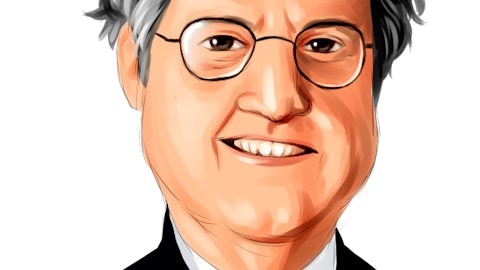Doug Shulman: Thanks, John.
Operator: Thank you. Our next question will come from Kevin Barker with Piper Sandler. Your line is open.
Kevin Barker: Thank you very much. I just wanted to follow up on some of the comments around asset yields and just margins in general. You’re pretty clear on asset yields continuing to improve due to seasonality through the year. But would you dig a little bit further in on the funding cost as well. I know the rest of the industry is under a lot of pressure and you have more fixed rate debt. But could we see a little incremental improvement due to the pay down of your maturing debt in the back half of the year, combined with issuance of some securitizations, maybe just a little more detail on what’s happening on the funding side? Thanks.
Micah Conrad: Yes, sure, Kevin. I think you kind of highlighted it properly. The vast majority of our debt is fixed rate, which does give us an advantage with respect to some of the increases we’ve been seeing in funding costs generally across the market. I think we designed our balance sheet for exactly these times when things were great in 2021. I know I’ve said it before, but 2020 and 2021, we really went heavy into unsecured and long duration debt when we were able to issue in the 3s. And that’s really helping us today, because for the last five issuances we’ve done going back to the early part of 2022, they’ve all been ABS on the secured lending side and kind of range right around I would average — call an average about 5%, so right around our average funding costs and that’s been an advantage for us.
So you’re seeing our interest expense not moving up dramatically. It was 4.6% a year ago and it’s 4.8% today. We think as we kind of move forward here because of the way we’ve structured this balance sheet, it just takes a while for changes in benchmark rates to really move through our interest expense. Just to give you a data point, our next 12 months of issuance from today forward to next March is only going to represent 10% of our average debt in 2024. So we feel really good about signaling kind of stable issuance and it will pick up a little bit, but it’s not going to be anything material. And I think that’s a big advantage for us in terms of our NIM and our profitability. We’ve talked a little bit about yield and how yields going to gradually return.
Some of the 90 plus subsides, assuming a positive macro future. And our operating leverage is something that’s incredibly strong as well for our profitability. When we add new loans, we’re adding 2% OpEx instead of 7, and so that helps us continue to generate the profitability we’re used to seeing.
Kevin Barker: Great. Thanks, Micah. And then a follow up on the tightening of underwriting from August 2022. You’ve long targeted about 6% to 7% net charge-off rate within the total book. But with the new originations being a much tighter underwriting, could we conceivably see structurally lower net charge-offs within the consolidate book or at least to new originations if we don’t see a spike in unemployment, or significantly more deterioration in the economy?
Micah Conrad: Yes, I think, Kevin, it’s hard to say, because that would require a little bit of prediction of the future economy, inflation still elevated, as you know. You can see from what we published on that page in our earnings deck are our September origination. So that was right after our pretty major tightening in August, our September origination six months later are tracking very, very similar to 2019 levels, which is not the best benchmark in the world, it’s one year, but it was the last period we had pre-pandemic. You can see the fourth quarter also tracking in line with those pre-pandemic levels. But we’re still focused generally on our returns, as you know, and so when we adjusted our credit box, we’re making sure that each of the loans and cohorts of loans that were originating are meeting that 20% return hurdle.
And what you’re seeing on those delinquency charts for vintage performance is really reflective of that. So we liked the earnings on those loans, we’ll have to see how the macro economy kind of moves forward from here. I would say if we do see a turn down in inflation and things kind of get a little back to normal without unemployment, we would expect to see some better credit performance as well. But that’s all to be seen in the future here.
Kevin Barker: Thank you, Micah.
Micah Conrad: Thanks.
Operator: Thank you. Our next question will come from Michael Kaye with Wells Fargo. Your line is now open.
Michael Kaye: Hi. Good morning. The quarter-on-quarter change in loans held up better than I expected. So I was wondering, are you seeing the impact of less seasonal payoffs during this year’s tax season? I think I heard you mentioned something about positive payment dynamics in your remarks. And also if there are less seasonal payoffs that you’re seeing, is this good or bad? It’s going to help net interest income as the loans are around longer, but could this be signs of upcoming consumer stress in a portfolio?
Doug Shulman: Yes, good question, Michael. I just referenced the payment dynamics when I was walking through some of the expectations. We are seeing similar patterns from what we do as this is tax season. So we typically will see increased payments, just people are getting tax refunds. We see a reduction in delinquency. And we were down 49 basis points quarter-over-quarter, which I said was it tends to be at the higher end of what we typically see. But average refunds from tax season are around 2,900 bucks versus they were 3,200 last year because of the child tax credit, but very much in line with pre-pandemic levels. So I would say from that perspective, we’re seeing pretty consistent payment trends relative to our expectations.
Early payments and payoffs for seasoned accounts are down versus the last couple of years. We see this as a sign of the competitive environment. The availability of credit and also effects from government stimulus continued to wear on that really influenced the last couple of years. I don’t see it as a credit challenge. These are actually accounts that are accretive to our earnings and our yield and they’re paying customers so we view this as a positive.
Michael Kaye: Okay. The next question is about funding. The secured mix you outlined is up to 55%. You got another 200 million maturing in the second half and another 1.3 billion in early 2024. How much longer are you going to be comfortable going without raising any unsecured debt? You haven’t raised your current debt in quite some time already. You probably don’t want to be out of that market for too long. So maybe you could provide some more color on that.
Doug Shulman: Yes, sure. As I said before, we have an incredibly strong balance sheet. Liquidity is really important to us. We’ve got 7.5 billion of committed bank lines that we can flex when needed. Those are largely undrawn today. One of the kind of positive dynamics of the asset backed securities as they do, we have revolving periods so we get some duration there. But once — they also start to amortize. So as they are amortizing down, if we’re putting on new ABS, it doesn’t move that mix as much. We really feel like if we needed to issue nothing but ABS for the remainder of the year, we certainly could without really having a big challenge in terms of our funding mix. Our long bonds — our long duration bonds, as you noted on our unsecured bonds, it’s been about a year and a half since we issued there.
We created that flexibility for ourselves in the way we structure the balance sheet. But in terms of the pricing, our longer duration bonds are trading in the mid 8s as of yesterday. You kind of had a new issue concession and convexity premiums for some of the deeper dollar discounts on the complex and you’re probably in the 9 area. So we will be opportunistic if we see an opportunity and an opening for unsecured, but we have no real need to do so. We feel pretty comfortable where we are.
Michael Kaye: Okay. Thank you.
Operator: Thank you. Our next question will come from Moshe Orenbuch. Your line is now open.
Moshe Orenbuch: Great, thanks. I was wondering maybe both Doug and Micah whether there’s a way to think about like what you need to see before you would expect to have kind of an increase in originations, sort of be able to underwrite more of those applications that are coming your way. And how to think about — maybe to give you the second part of the question at the same time, how to think about that 5% decline year-on-year, or what’s the amount if credit had normalized that that number, how much higher do you think that number could be?
Micah Conrad: Yes. Look, Moshe, if I’m interpreting your question to be like what would it take for us to open up our credit box? And look, one, I’d say, as we mentioned in our remarks, we still have an uncertain macro picture. Clearly, unemployment is a bright spot, low unemployment and it looks promising that inflation is starting to moderate, but inflation is definitely still impacting customers. I think we’ve now shown in two quarters that our post tightening originations are performing as expected. And I think we need to see a couple more months of that just to feel comfortable that that trend is staying. We’re super careful stewards of our shareholders capital. And we’ve said before that we’re going to be conservative with our balance sheet and conservative with underwriting and we’re going to be innovative and aggressive when it comes to product innovation, customer experience, digital, et cetera.
We very well may be leaving money on the table, but we’re okay with that, given the uncertainty in the environment. I think if we started to open up, it’s not going to be a big bang where we say coast is clear, let’s just open up the credit box. It’s going to be by state, depending on what we can charge by risk grade of customer. We now have a set of products. We have a secured and an unsecured loan. We have two flavors of credit card; one with a fee, one without a fee. And so we’d be looking at pockets. What I will tell you is we are always booking loans right at the margin of loans that don’t meet our credit box in very small quantities that we test, we call it weather vane. So we’ve always got loans out in the market to see how they’re performing just below our credit standards, and that data helps tell us kind of how are things performing.
It’s not material to our book, but it’s just part of how we go. So look, what I would say is right now where we’d like the market share, we’re picking up and as we mentioned, originations are above expectations already with a tight credit box. I think we’re just going to have to keep watching our book and the economy. And we’ll move when — we’ll open up the box more when we feel comfortable doing it, but it’s not right now.





